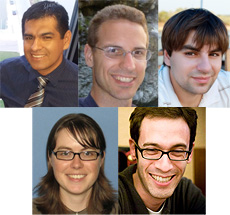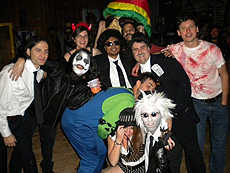FSPA welcomes new officers
 |
New officers of the Fermilab Student and Postdoc Association recently began their terms. Top, from left: Leonidas Aliaga, College of William and Mary; Anthony Barker, Rutgers University; Vladimir Khalatyan, Northern Illinois University. Bottom, from left: Carrie McGivern, University of Pittsburgh; Jason St. John, Boston University.
|
Earlier this month the Graduate Student Association got a name change, rebranding itself as the Fermilab Student and Postdoc Association to reflect the diverse population it aims to represent.
Now it's also undergone a change in leadership. Last week, the association elected new officers to lead FSPA members for the 2012-13 term.
"We're grateful to all the former officers for the work they put into making Fermilab an active and social place to do research," said new officer Vladimir Khalatyan from Northern Illinois University. "We plan to continue their efforts to make Fermilab an interesting place to work for students and postdocs."
The new FSPA officers are Leonidas Aliaga, Anthony Barker, Jason St. John, Vladimir Khalatyan and Carrie McGivern.
FSPA acts as a liaison between the directorate, experiment managers, the Users' Executive Committee and the Fermilab postdoc and student population, disseminating information on employment opportunities and helping with education and outreach programs.
This year's officers hope to build FSPA's strength in all these areas.
"This is a great opportunity for the group, a reinvention if you will," said McGivern, a postdoc at the University of Pittsburgh. "With the expansion to formally include postdocs, we can now reach out to a larger part of the lab. This will be especially helpful for new postdocs, as well as students, who are visiting Fermilab, or the U.S., for the first time."
FSPA also encourages interaction among students and postdocs from all different parts of the laboratory. One of the first social events the new officers will host is the annual FSPA Halloween party, which takes place Friday, Nov. 2, at 6 p.m. in Kuhn Barn. All are invited to attend. Costumes are optional but encouraged.
Those interested in joining in on FSPA events are invited to subscribe to the association's e-mail list.
—Leah Hesla
 |
Scientists and friends look spooktacular at the 2010 Halloween party hosted by the Graduate Student Association, now the Fermilab Student and Postdoc Association. Photo: FSPA
|
|